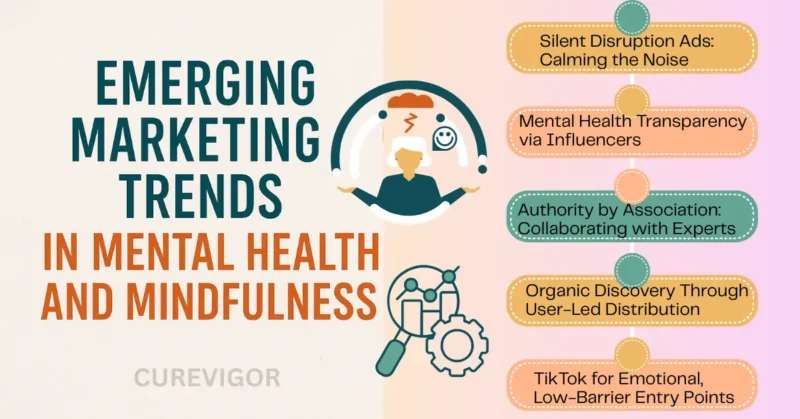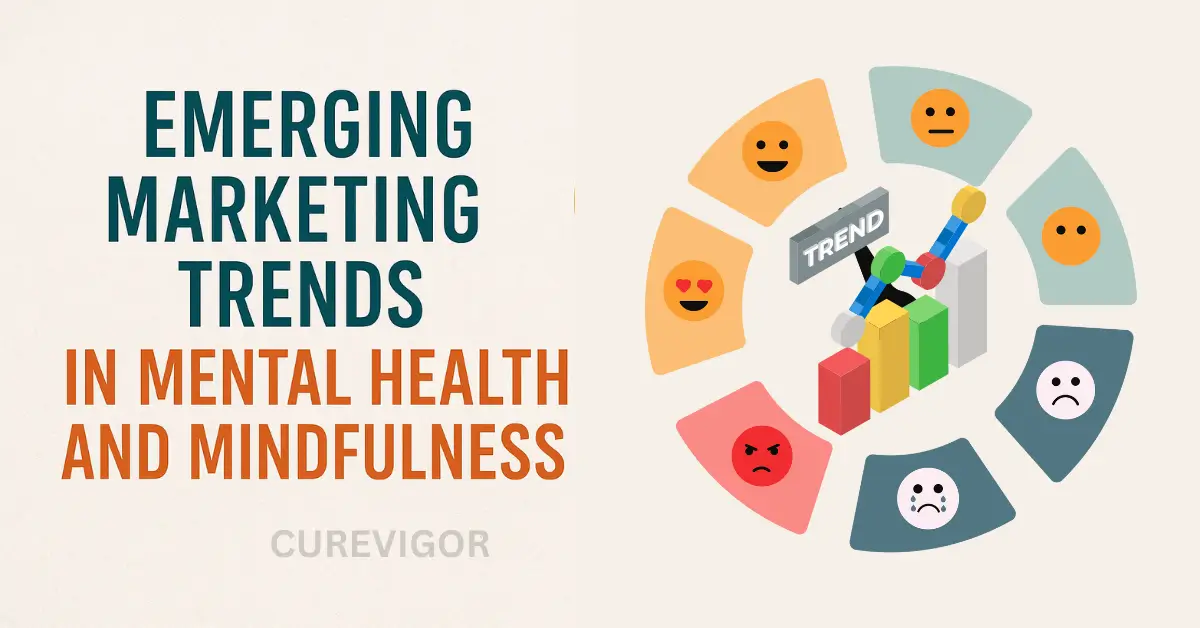Stay ahead of marketing trends in mental health and mindfulness, as brands reshape wellness marketing through influencer transparency and platforms like TikTok.
Thank you for reading this post, don't forget to subscribe!Key trends include authenticity, influencer openness, expert collaborations, user-driven content, and TikTok strategies. Brands using these methods build trust and connect with wellness-focused audiences online.
How Marketing Trends Are Shaping Mental Health and Mindfulness
The mental health and mindfulness industries are no longer niche corners of wellness. They are now mainstream. With growing awareness of stress, anxiety, and holistic well-being, consumers seek support for both mental and emotional health.
For brands in this space, understanding emerging marketing trends is not just useful—it’s essential for staying relevant and trustworthy.
This article examines the latest marketing techniques transforming the field of mindfulness and mental wellness. From silent disruption ads to influencer transparency, these trends highlight how authenticity, creativity, and human connection are driving the next phase of wellness marketing.
Emerging Marketing Trends Transforming Mental Health and Mindfulness
The mental health and mindfulness industry is undergoing rapid change as consumers demand more authentic, compassionate, and engaging approaches.

These emerging marketing trends highlight how brands can build trust, foster community, and connect with audiences in meaningful ways while staying relevant in a competitive wellness market.
1. Silent Disruption Ads: Calming the Noise
Traditional advertising has long thrived on attention-grabbing tactics—bright colors, loud jingles, fast-paced editing, and a sense of urgency that pressures people to “act now.”
While this strategy is effective in some industries, it can be perceived as intrusive and counterproductive in the mental health and mindfulness sectors. When someone is already overwhelmed, the last thing they want is an ad that adds to the noise.
This is where silent disruption ads step in. Instead of shouting for attention, these ads invite the audience to pause, breathe, and engage at their own pace. Think of a video where the sound of falling rain replaces background music, or where soft visuals of nature unfold slowly without a single spoken word.
Brands like Calm and Headspace have pioneered this approach, offering viewers a mini-mindfulness session within the ad itself.
The genius behind silent disruption is twofold:
- Psychological Impact: By breaking away from the sensory overload of conventional ads, silence becomes noticeable. A quiet, serene ad in the middle of loud commercial breaks instantly captures attention—not by demanding it, but by offering relief.
- Lifestyle Alignment: These ads reflect the very values mindfulness consumers live by—simplicity, stillness, and inner peace. When a brand communicates in the same tone as the lifestyle it promotes, it builds authenticity and trust.
For businesses, adopting this minimalist, serene advertising style doesn’t have to mean cutting corners. It can involve slow-motion visuals, subtle brand placement, or gentle ambient sounds that evoke an emotional resonance.
Some brands even incorporate interactive elements—such as inviting viewers to close their eyes for 10 seconds during the ad—to create a memorable, calming experience.
Silent disruption ads do more than build brand awareness. They can improve brand recall because they stand out from the usual clutter. People remember a brand that made them feel calm, even briefly, more than one that overwhelms with flashy messages.
In a world where consumers crave mental clarity, silence isn’t just golden—it’s a powerful marketing trend. This strategy can become a defining characteristic for new wellness companies, differentiating them from rivals who continue to use antiquated, coercive advertising.
2. Mental Health Transparency via Influencers
Influencer marketing is evolving. In industries such as fashion and beauty, influencers often showcase polished lifestyles. But when it comes to mental health marketing, the rules are different. What resonates most is vulnerability and honesty.
Audiences are tired of picture-perfect narratives; they’re seeking influencers who admit, “I struggle too.” For example, when a wellness brand collaborates with an influencer who talks openly about their anxiety, burnout, or therapy sessions, the message becomes more relatable.
Instead of feeling like a sales pitch, it feels like advice from a trusted friend. This transparency creates emotional resonance. Followers see themselves in the influencer’s story, building loyalty and trust. Studies show consumers are more likely to support brands they believe are authentic in addressing mental health.
Brands can elevate this trend by:
- Encouraging long-form storytelling through blogs, YouTube, or podcasts where influencers share their wellness journeys.
- Promoting vulnerability campaigns, where influencers reveal “unfiltered” sides of their lives to highlight realistic self-care practices.
- Focusing on community interaction, where influencers host live Q&A sessions about mental health, turning marketing into dialogue.
By prioritizing transparency, brands create meaningful partnerships and demonstrate they’re not just selling products—they’re fostering conversations that matter.
3. Authority by Association: Collaborating with Experts
The mental health industry thrives on credibility. Consumers want assurance that the advice, products, or services they invest in are backed by expertise. This has given rise to one of the strongest marketing trends: authority by association.
Wellness companies are no longer creating all content themselves. Instead, they involve licensed therapists, meditation coaches, neuroscientists, and thought leaders.
A podcast featuring a mindfulness coach or an article written by a psychologist can help establish brand authority. Co-created meditation courses also help boost credibility.
Here’s why it works:
- Trust Building: Expert voices lend credibility that self-promotion cannot.
- Educational Value: Collaborations add depth, offering audiences both inspiration and actionable advice.
- Differentiation: In a market saturated with generic wellness content, expert insights stand out as reliable and unique.
Some brands even co-develop certifications or wellness programs in partnership with recognized institutions, further solidifying their reputation. By leveraging expert collaborations, companies position themselves not only as service providers but as leaders shaping the future of mental health and mindfulness.
4. Organic Discovery Through User-Led Distribution
Consumers no longer want to be passive. They want to contribute. This shift has led to the emergence of user-generated content (UGC) in the wellness marketing sector.
In mental health, this could mean posting a meditation playlist, sharing journal prompts, or documenting a daily mindfulness ritual.
This approach transforms consumers into co-creators. Every testimonial, social media story, or TikTok challenge shared by users acts as free advertising that feels authentic and trustworthy.
Here’s how brands can maximize UGC:
- Create branded hashtags that invite users to share their mindfulness practices.
- Host challenges (e.g., “7-Day Calm Challenge”), encouraging participants to document their progress.
- Highlight community stories by resharing user posts, reinforcing a sense of belonging.
UGC not only drives engagement but also increases organic discovery. When people see their peers advocate for a product, it feels more genuine than a polished ad. This ripple effect helps brands expand their reach without overspending.
In an industry built on connection and support, empowering users to become storytellers transforms customers into advocates—and advocates into loyal communities.
5. TikTok for Emotional, Low-Barrier Entry Points
TikTok has completely changed how people consume material, especially among young millennials and Gen Z. In mental health and mindfulness, it offers a straightforward and engaging way to connect with audiences through concise and emotionally charged content.
What makes TikTok unique is its relatability. Users do not expect professional videos or scripts. Instead, raw, authentic videos succeed—like a short meditation tip, a quick breathing exercise, or a reminder to take breaks. These micro-moments make wellness accessible.
Brands are using TikTok to:
- Normalize mental health conversations by breaking the stigma through short, digestible content.
- Leverage influencers, who share practical wellness hacks in a friendly, non-promotional way.
- Tap into trending sounds and challenges, blending mental health messages with pop culture to broaden appeal.
For example, a mindfulness brand might join a trending TikTok challenge but reframe it to emphasize stress-relief techniques. This dual approach keeps content culturally relevant while promoting wellness.
The payoff is huge: TikTok’s algorithm rewards genuine engagement. Even small brands can go viral if their content connects emotionally with users. By utilizing this platform, wellness businesses can connect with young audiences who seek honest conversations about mindfulness and wellness.
Key Takeaways
Silent disruption ads: Brands embrace calm, quiet approaches to capture attention and enhance recall in wellness marketing.
- Influencer transparency: Brands leverage honest influencer stories to build relatable, authentic connections with their audience.
- Expert collaborations: Brands partner with industry professionals to improve credibility and build consumer trust.
- User-generated content: Brands empower customers to share real experiences, boosting trust and organic growth.
- TikTok marketing: Brands utilize authentic, relatable short-form content to connect with and engage younger, wellness-focused audiences.
FAQs
Q. What are the latest marketing trends in mental health and mindfulness?
The latest marketing trends in mental health and mindfulness include silent disruption ads, influencer transparency, expert collaborations, user-generated content, and TikTok campaigns.
These approaches focus on authenticity and connection rather than pushy promotion. Brands that utilize these strategies foster trust, engage with their communities, and differentiate themselves in the rapidly growing wellness industry.
Q. Why is authenticity important in mental health marketing?
Authenticity is vital in mental health marketing because audiences value transparency and real experiences over polished perfection. Consumers trust brands that openly support mental health awareness and showcase relatable stories.
By being authentic, companies build long-term credibility, strengthen emotional bonds, and position themselves as supportive partners in wellness rather than just sellers.
Q. How can influencers impact mindfulness marketing?
Influencers play a key role in mindfulness marketing by sharing their personal mental health journeys and self-care practices. Their openness creates relatability and encourages audiences to engage with wellness products or services.
Partnering with authentic influencers enables brands to reach new communities, normalize mental health discussions, and enhance credibility in a sensitive industry.
Q. What role does TikTok play in mental health marketing trends?
TikTok has become a powerful tool for mental health marketing, offering low-barrier entry points through short, relatable videos. Wellness brands utilize TikTok to share meditation tips, stress-relief hacks, and positive reminders that resonate with younger audiences.
The platform’s algorithm supports organic reach, making it ideal for authentic, community-driven wellness campaigns.
Q. How does user-generated content help wellness brands grow?
User-generated content (UGC) boosts wellness brand growth by turning customers into brand advocates. When people share their meditation practices, journaling routines, or wellness progress online, it feels authentic and trustworthy.
UGC creates organic brand discovery, strengthens community engagement, and reduces ad costs, making it one of the most effective trends in mental health marketing.
Final Word
The future of mental health and mindfulness marketing is built on empathy, creativity, and trust. These emerging marketing trends indicate that successful brands are no longer those with the loudest voices, but rather those with the most authentic connections.
In a world where stress and disconnection are daily struggles, audiences crave brands that bring calm, offer genuine support, and engage in honest conversations.
By embracing transparency, collaboration, and community-led storytelling, businesses in the wellness space can ensure their marketing does more than sell—it heals, inspires, and empowers.
Ready to stay ahead in the wellness space? Embrace these emerging marketing trends in mental health and mindfulness to connect with your audience authentically. Start applying these strategies today and build a brand that inspires trust, balance, and lasting impact.
Read more articles on Health & Wellness Tips.
You might like to read:

